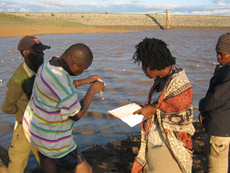In Southern Africa’s Limpopo River Basin, WANI showed managers how to assess how much water could be made available for different uses while keeping the river ecosystem healthy. Professional training, exchange programmes, and demonstration projects built the capacity of local water managers and, eventually, the project spurred cooperation throughout the entire Southern Africa Development Community (SADC) region.
South Africa, Zimbabwe, Botswana, Mocambique
The Limpopo River Basin, a major transboundary basin, extends through Botswana, Zimbabwe, South Africa and Mozambique covering an area of 415,000 km2 with a length of approximately 1,700 km, draining into the Indian Ocean. It is one of the most developed basins in southern Africa with its natural flow modified by numerous dams. As a result, surface flow in the main channel ceases entirely in winter.
WANI set out to convey the concept of “environmental flows,” in which water managers can assess how much water is available for different purposes, while retaining enough water in the river to support its ecosystem. It facilitated field exchange visits by nine Limpopo River Basin managers to observe results of environmental flows management in the Lesotho Highlands Water Project and the Pangani River Basin. In partnership with GWP Southern Africa, WaterNet, UNESCO and the South Africa Department of Water Affairs, the project staged a 10-day regional training course, in which 34 water practitioners and managers from all 11 SADC countries took part.
In Zimbabwe’s Mzingwane catchment, a sub-catchment of the Limpopo, WANI demonstrated how to conduct an environmental flows assessment. Wet and dry season assessments of hydrology and water resources, water quality, hydraulics, geomorphology, aquatic ecology, botany, fisheries, agriculture, economics and social issues were completed by a multi-disciplinary team of specialists. Their analysis predicted specific changes in river conditions as a result of changes in the quantity and timing of flow allocations from the Mzingwane dam. Scenarios for improving river health by managing water releases from the dam were developed through a participatory workshop. Concurrently, a policy review recommended estimating the direct and indirect costs of degraded rivers to national economies to justify investment in managing environmental flows.
The project culminated in the formation of a Southern Africa Regional Environmental Flows Network. Participants include managers from the Limpopo River Basin Commission, SADC Water Resources Technical Committee, and water directors from member states. The network aims to increase access to technical expertise, promote sharing of experience, reform policy and legal frameworks and catalyze action on project recommendations, including using environmental flows in the Mzingwane and Blyde rivers.
Resources:
Story: Limpopo River Basin
Managing Flows for Sustainable Development Learning from the Limpopo River Basin
